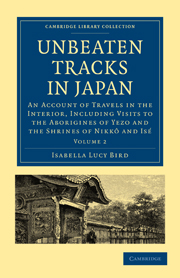 Unbeaten Tracks in Japan
Unbeaten Tracks in Japan Book contents
- Frontmatter
- Contents
- LIST OF ILLUSTRATIONS
- ERRATA
- NOTES ON YEZO
- LETTER XXXVIII
- LETTER XXXIX
- LETTER XL
- LETTER XL.–(Continued)
- LETTER XLI
- LETTER XLI.–(Continued.)
- LETTER XLII
- LETTER XLII–(Continued)
- LETTER XLII–(Continued)
- LETTER XLIII
- LETTER XLIV
- LETTER XLIV.–(Continued.)
- LETTER XLV
- LETTER XLV.–(Continued.)
- LETTER XLVI
- ITINERARY OF TOUR IN YEZO
- LETTER XLVII
- LETTER XLVIII
- LETTER XLIX
- NOTES ON TÔKIYÔ
- NOTES ON TÔKIYÔ–(Concluded.)
- LETTER L
- LETTER LI
- LETTER LII
- LETTER LIII
- LETTER LIV
- LETTER LV
- NOTES ON THE ISÉ SHRINES
- LETTER LVI
- LETTER LVII
- ITINERARY OF ROUTE FROM KIYÔTO TO YAMADA (SHRINES OF ISÉ), AND BY TSU TO KIYÔTO
- LETTER LVIII
- LETTER LIX
- A CHAPTER ON JAPANESE PUBLIC AFFAIRS
- APPENDIX
- INDEX
A CHAPTER ON JAPANESE PUBLIC AFFAIRS
Published online by Cambridge University Press: 05 October 2010
- Frontmatter
- Contents
- LIST OF ILLUSTRATIONS
- ERRATA
- NOTES ON YEZO
- LETTER XXXVIII
- LETTER XXXIX
- LETTER XL
- LETTER XL.–(Continued)
- LETTER XLI
- LETTER XLI.–(Continued.)
- LETTER XLII
- LETTER XLII–(Continued)
- LETTER XLII–(Continued)
- LETTER XLIII
- LETTER XLIV
- LETTER XLIV.–(Continued.)
- LETTER XLV
- LETTER XLV.–(Continued.)
- LETTER XLVI
- ITINERARY OF TOUR IN YEZO
- LETTER XLVII
- LETTER XLVIII
- LETTER XLIX
- NOTES ON TÔKIYÔ
- NOTES ON TÔKIYÔ–(Concluded.)
- LETTER L
- LETTER LI
- LETTER LII
- LETTER LIII
- LETTER LIV
- LETTER LV
- NOTES ON THE ISÉ SHRINES
- LETTER LVI
- LETTER LVII
- ITINERARY OF ROUTE FROM KIYÔTO TO YAMADA (SHRINES OF ISÉ), AND BY TSU TO KIYÔTO
- LETTER LVIII
- LETTER LIX
- A CHAPTER ON JAPANESE PUBLIC AFFAIRS
- APPENDIX
- INDEX
Summary
The new era dates from 1868. Up to the twelfth century Japan was ruled by the Mikado, who was believed to be directly descended from the gods who created the country. This ruler by “divine right” exercised his absolute power through the Kugé or court nobles, mostly connections of his own, who monopolised the chief offices, constituted the membership of the two great councils which arranged religious and secular affairs, and filled the principal posts in the eight executive departments of the Empire.
After the twelfth century, when the feudal system rose, the governing power gradually passed out of the hands of the Mikado and his nobles into those of the great feudal families, and in 1603 became concentrated in Iyéyasu, the head of the Tokugawa dynasty, successive members of which exercised it for two centuries and a half. All this time a shadowy Mikado nominally reigned in the old palace in Kiyôto, but power and splendour had passed to his chief vassal, who, under the title of Shôgun, actually ruled from the Castle of Yedo, and was usually strong enough to impose his will on his sovereign. It was this system of dual government which gave rise to the fiction of “spiritual” and “temporal” Emperors.
The daimiyô were feudal princes, who, having originally conquered their domains by the sword, exercised independent jurisdiction within their limits, but were bound to render certain acts of homage to the Shôgun, whose government was composed of those among them on whose loyalty he could rely.
- Type
- Chapter
- Information
- Unbeaten Tracks in JapanAn Account of Travels in the Interior, Including Visits to the Aborigines of Yezo and the Shrines of Nikkô and Isé, pp. 311 - 348Publisher: Cambridge University PressPrint publication year: 2010First published in: 1880
